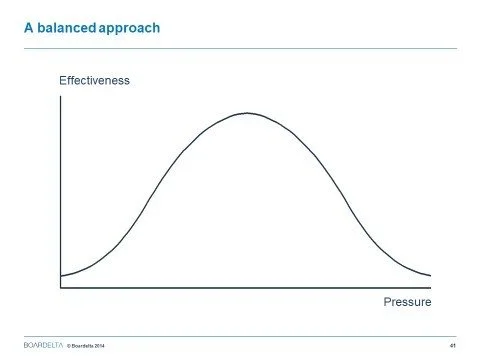Resilience - The Prize, The Price and Organisational Pilates
It’s almost a decade since the death of South Africa’s extraordinary President Nelson Mandela. Amongst his many qualities was his remarkable resilience. Abundant evidence of this is provided in his book “The Long Walk to Freedom” as well as numerous accounts from others.
It’s over 100 years since Harriet Tubman, the legendary war nurse, spy and underground railroad conductor died. A former slave, Harriet was not only remarkable for rescuing slaves through the underground railroad. Like Nelson Mandela, she also had the ability to forgive her former oppressors and to prioritise reconciliation even if it meant paying a deep personal price.
Fortunately, few of us will ever have to pay the price or face the extraordinary physical and mental challenges that they or other legends of resilience have experienced. Neither though will we be able to achieve the sense of fulfilment that they must have felt in gaining the prize of universal suffrage for a nation or liberating so many slaves.
Relating to and applying things from extraordinary people or situations to our own situation can be tough, especially when we are uncertain or our self-confidence has had a blow. Yet, when it comes to resilience, I think that we can learn a lot from these legends of resilience to help us deal with what feels like an increasingly threatening and uncertain world.
What do we mean by resilience?
“The capacity and capability to withstand or recover from difficulties.” Is my preferred description.
Capacity and capability feel equally important. The experience of the last few years has probably strengthened capabilities. Yet in many cases it has also eroded capacity. Fatigue and anxiety can reduce our capacity not just to deal with challenge but also to perform even routine activities.
Nietzsche’s much used quote “If it doesn’t kill you, it will make you stronger”, sadly may not always hold true. There are many “Walking dead” organisations and people in them who are damaged for life who have experienced “Difficulties”. However, I still found it uplifting while writing this to listen to Bruce Springsteen singing Jerry Butler’s “Only the strong survive”. I believe passionately that experiences where resilience is tested are great opportunities to reflect, to learn and to improve.
Views seem to vary as to whether self-inflicted difficulties are tougher to deal with than those coming from outside. Reputation preservation can be a powerful motive when the situation is self-inflicted though credibility and objectivity might be impaired and the appeal for help less strong.
The line between resilience and endurance is easy to blur. Endurance is an element of resilience, but resilience requires more than the ability just to put up with something.
What’s the point of being resilient?
If we are going to have to endure pain or put ourselves at risk and not simply walk away from a situation then the potential upside has to be worth it. There has to be a point.
For many leaders in the last few years who have faced existential threats from the pandemic, the energy or cost of living crisis, survival has been the galvanising goal. For others it’s about the “Eyes on the prize” and as I am writing this on the day of the London Marathon, a marathon runner’s “No pain no gain” mindset.
The final words from Mandela’s closing statement at the Rivonia trial which convicted him to life imprisonment in 1964 were:
“During my lifetime I have dedicated myself to this struggle of the African people. I have fought against white domination, and I have fought against black domination. I have cherished the ideal of a democratic and free society in which all persons live together in harmony and with equal opportunities. It is an ideal which I hope to live for and to achieve. But if needs be, it is an ideal for which I am prepared to die.”
He endured 27 years in prison for this ideal before being released in 1990 and then enabling universal suffrage in South Africa in 1994. One of his most famous quotes was that “I never lose, I only win or I learn”. Life imprisonment might not seem like winning to you or I, but for Nelson Mandela the grim alternative in 1964 was a death sentence. So to him it felt like winning.
There is no doubt he learnt an enormous amount in prison that was useful, not least a whole host of strategies to strengthen his resilience including physical exercise, diet and a motivating and never-ending desire for learning. He also knew that he did lose many things in addition to his freedom in gaining the prize of a vote for his people. Not least from a family perspective,.
The bottom line is that resilience in the face of extreme difficulties can make us stronger but it usually comes at a price. So, you have to judge whether the prize is worth the price. Good judgement is a hallmark of those that prove to be resilient.
Managing the Effectiveness and Pressure curve:
Capacity to withstand and perform under pressure is another hallmark of the resilient. The chart below from my Boards book has been of great help to me in challenging situations over many years. Put simply the message is “No pressure – no effectiveness”, we’re asleep. “Too much pressure – no effectiveness”, we’re headless chickens. “Right amount of pressure we perform strongly”, we stand the best chance of success.
Logically, a high degree of self-awareness should improve resilience as it helps us understand what causes us pressure, where we are on the curve and to know our tensile strength so we have a better idea of how far we can be stretched before we snap. Obvious ways to up self-awareness on resilience are through feedback, benchmarking, scenario and crisis management planning and simulations.
Different things cause different people pressure and we don’t all have the same tolerance to different types of pressure. In my experience of crisis situations quality of relationships, confidence in the competence of others and trust often far outweigh workload and other more obvious causes of pressure.
The curve is also helpful for non-execs to be thinking about when tempted to pile on the pressure for their executive colleagues when they are already highly stretched. During the pandemic I saw so many uplifting occasions where non execs provided tremendous support to their executive to reduce their burden and help them get through. Sadly there were others who just flapped about, got in the way and increased the burden.
Resilient organisations:
Resilient organisations depend upon having resilient people with resilient mind-sets, but they need more than that.
The 2008 financial crisis revealed that many financial institutions and the system itself were ill prepared for it and far more fragile than they appeared. The pandemic revealed many other vulnerabilities to our resilience including supply chain fragility, weak processes and unhelpful cultures.
If we turn to the research, a popular model is the “7 Cs resilience model” developed by Philadelphia based paediatrician Ken Ginsberg, MD, to help children and adolescents build resilience. His 7 Cs are: competence, confidence, connection, character, contribution, coping, and control. His thesis was that with all these skills and factors in place we can build inner strength and mobilise other resources to help us — regardless of age.
The purpose, people, process approach described in Boards can also be helpful. It is based on a belief that clarity and alignment of purpose combined with the right people working together in the right way supported by effective process should lead to high performance.
It’s the same when thinking about resilience. Our motives need to be clear; we need the right capacity and capabilities, but we also need the right systems and processes in place.
The Chief Financial Officer is right at the heart of this. They are responsible for many of the core resilience processes. They are so often the organisations meerkats, scanning the horizon. Using their finely tuned antennae for hazard identification and interpersonal skills and influence to get the rest of the pack to safety in time.
SAP Concur's CFO Insights - Another year of uncertainty- CFOs become paragons of business resiliency is worth a read. Unsurprisingly digital, inflation, sustainability and attracting and retaining talent being the core themes.
Scenario planning, simulation and other resilience muscle development exercises have been used for years but I sense and have experienced recently a greater degree of seriousness in the way organisations are approaching these now.
The pandemic has increased appreciation of the need to increased agility and at least for the moment the appreciation of those who are calm and considered has also risen.
Ability to manage conflict:
The ability to manage conflict well is an important component of leadership. Whether its conflicting objectives, ideas, perspectives or personalities, the ability to navigate them, to maximise the benefits of diversity and achieve alignment of purpose and to motivate those with different motivations is a core leadership capability. Especially when the organisation is challenged.
To be able to react rather than respond, distinguish between fact and interpretation, choose whether to compete, collaborate, compromise, avoid or accommodate, to build trust and create a culture that values difference and different contributions and gets things done is far from easy.
Investment in the development of these skills, especially before we get into a situation where they become critical is likely to deliver a good return.
So,is the prize of greater resilience worth the price?
The prize of greater resilience goes well beyond a higher probability of survival or organisational sustainability. Greater core resilience provides a source of strength, an organisational Pilates if you like, for all that we do. It provides the mutual support, balance, muscle strengthening calm and joy shown in the opening image that we need when we are stretched. Sure, it comes at a price in terms of investment time and increased governance. Yet, if we think in return on investment rather than budget terms, as Mandela said we will “Never lose, only win or learn”.
Written by Patrick Dunne, Experienced Chair and author of the award-winning book “Boards”. This article was first published on LinkedIn.



